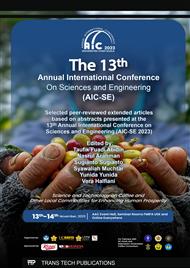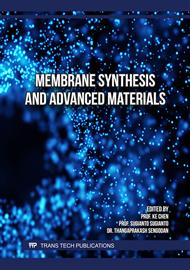[1]
Y. Tang, Y. Lin, W. Ma, and X. Wang, "A review on microporous polyvinylidene fluoride membranes fabricated via thermally induced phase separation for MF/UF application," J. Memb. Sci., vol. 639, no. August, p.119759, 2021.
DOI: 10.1016/j.memsci.2021.119759
Google Scholar
[2]
H. Nawaz, M. Umar, A. Ullah, H. Razzaq, K. M. Zia, and X. Liu, "Polyvinylidene fluoride nanocomposite super hydrophilic membrane integrated with Polyaniline-Graphene oxide nano fillers for treatment of textile effluents," J. Hazard. Mater., vol. 403, no. February 2020, p.123587, 2021.
DOI: 10.1016/j.jhazmat.2020.123587
Google Scholar
[3]
F. Liu, M. R. M. Abed, and K. Li, "Preparation and characterization of poly(vinylidene fluoride) (PVDF) based ultrafiltration membranes using nano γ-Al2O3," J. Memb. Sci., vol. 366, no. 1–2, p.97–103, 2011.
DOI: 10.1016/j.memsci.2010.09.044
Google Scholar
[4]
P. Boruah, R. Gupta, and V. Katiyar, "Fabrication of cellulose nanocrystal (CNC) from waste paper for developing antifouling and high-performance polyvinylidene fluoride (PVDF) membrane for water purification," Carbohydr. Polym. Technol. Appl., vol. 5, Jun. 2023.
DOI: 10.1016/j.carpta.2023.100309
Google Scholar
[5]
E. Yuliwati and A. F. Ismail, "Effect of additives concentration on the surface properties and performance of PVDF ultrafiltration membranes for refinery produced wastewater treatment," Desalination, vol. 273, no. 1, p.226–234, 2011.
DOI: 10.1016/j.desal.2010.11.023
Google Scholar
[6]
J. E. Lee, Y. E. Shin, G. H. Lee, J. Kim, H. Ko, and H. G. Chae, "Polyvinylidene fluoride (PVDF)/cellulose nanocrystal (CNC) nanocomposite fiber and triboelectric textile sensors," Compos. Part B Eng., vol. 223, no. May, p.109098, 2021.
DOI: 10.1016/j.compositesb.2021.109098
Google Scholar
[7]
A. K. Sari et al., "Effect of acid treatments on thermal properties of bacterial cellulose produced from cassava liquid waste," Mater. Today Proc., vol. 57, p.1174–1178, 2022.
DOI: 10.1016/j.matpr.2021.10.130
Google Scholar
[8]
A. Karimian et al., "Nanocrystalline cellulose: Preparation, physicochemical properties, and applications in drug delivery systems," Int. J. Biol. Macromol., vol. 133, p.850–859, 2019.
DOI: 10.1016/j.ijbiomac.2019.04.117
Google Scholar
[9]
K. K. Sadasivuni, D. Ponnamma, H. U. Ko, H. C. Kim, L. Zhai, and J. Kim, "Flexible NO2 sensors from renewable cellulose nanocrystals/iron oxide composites," Sensors Actuators, B Chem., vol. 233, no. 2, p.633–638, 2016.
DOI: 10.1016/j.snb.2016.04.134
Google Scholar
[10]
A. Santamaria-Echart, L. Ugarte, C. García-Astrain, A. Arbelaiz, M. A. Corcuera, and A. Eceiza, "Cellulose nanocrystals reinforced environmentally-friendly waterborne polyurethane nanocomposites," Carbohydr. Polym., vol. 151, p.1203–1209, 2016.
DOI: 10.1016/j.carbpol.2016.06.069
Google Scholar
[11]
C. Gomri, M. Cretin, and M. Semsarilar, "Recent progress on chemical modification of cellulose nanocrystal (CNC) and its application in nanocomposite films and membranes-A comprehensive review," Carbohydr. Polym., vol. 294, Oct. 2022.
DOI: 10.1016/j.carbpol.2022.119790
Google Scholar
[12]
L. Bai, A. Ding, G. Li, and H. Liang, "Application of cellulose nanocrystals in water treatment membranes: A review," Chemosphere, vol. 308. Elsevier Ltd, Dec. 2022.
DOI: 10.1016/j.chemosphere.2022.136426
Google Scholar
[13]
X. Zhang, H. Li, M. Ye, H. Zhang, G. Wang, and Y. Zhang, "Bacterial cellulose hybrid membrane grafted with high ratio of adipic dihydrazide for highly efficient and selective recovery of gold from e-waste," Sep. Purif. Technol., vol. 292, Jul. 2022.
DOI: 10.1016/j.seppur.2022.121021
Google Scholar
[14]
M. M. Aji, S. Narendren, M. K. Purkait, and V. Katiyar, "Biopolymer (gum arabic) incorporation in waste polyvinylchloride membrane for the enhancement of hydrophilicity and natural organic matter removal in water," J. Water Process Eng., vol. 38, no. June, p.101569, 2020.
DOI: 10.1016/j.jwpe.2020.101569
Google Scholar
[15]
W. Y. Bang et al., "Influence of cellulose nanocrystal addition on the production and characterization of bacterial nanocellulose," Int. J. Biol. Macromol., vol. 193, p.269–275, Dec. 2021.
DOI: 10.1016/j.ijbiomac.2021.10.092
Google Scholar
[16]
W. Deng and Y. Li, "Novel superhydrophilic antifouling PVDF-BiOCl nanocomposite membranes fabricated via a modified blending-phase inversion method," Sep. Purif. Technol., vol. 254, Jan. 2021.
DOI: 10.1016/j.seppur.2020.117656
Google Scholar
[17]
D. Zhang et al., "Fabrication of antifouling and antibacterial polyethersulfone (PES)/cellulose nanocrystals (CNC) nanocomposite membranes," J. Memb. Sci., vol. 549, no. November 2017, p.350–356, 2018.
DOI: 10.1016/j.memsci.2017.12.034
Google Scholar
[18]
P. Shrestha, M. B. Sadiq, and A. K. Anal, "Development of antibacterial biocomposites reinforced with cellulose nanocrystals derived from banana pseudostem," Carbohydr. Polym. Technol. Appl., vol. 2, p.100112, 2021.
DOI: 10.1016/j.carpta.2021.100112
Google Scholar
[19]
M. Kadhom and B. Deng, "Thin film nanocomposite membranes filled with bentonite nanoparticles for brackish water desalination: A novel water uptake concept," Microporous Mesoporous Mater., vol. 279, no. November 2018, p.82–91, 2019.
DOI: 10.1016/j.micromeso.2018.12.020
Google Scholar




